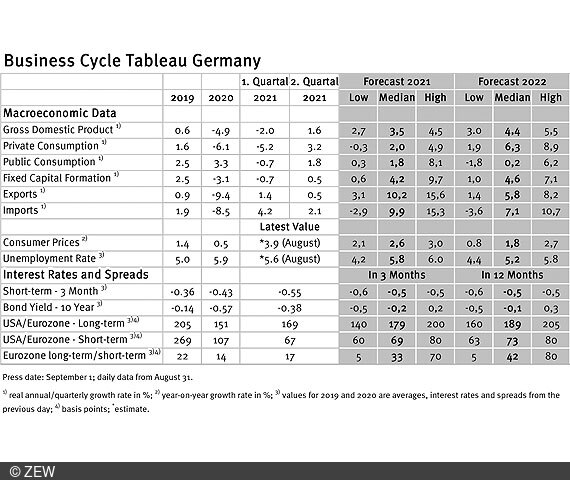Only Slightly Changed Economic Forecasts for 2021/22
Business Cycle Tableaus by ZEW and Börsen-ZeitungEconomists Remain Optimistic About German Economy
Economic experts expect consumer prices to continue to rise, but still consider this to be only a short-term phenomenon. Moreover, they are confident that the German economy has now embarked on a fairly stable growth path. This is the result of the business cycle tableaus by ZEW Mannheim and the German daily newspaper, Börsen-Zeitung.
The growth forecasts for Germany for this year were slightly revised downwards, from 3.6 per cent to 3.5 per cent; in contrast, the median forecasts for next year were raised somewhat, from 4.3 per cent to currently 4.4 per cent. The available figures for the second quarter show that real gross domestic product (GDP) declined by about 0.4 percentage points overall in the first half of the year.
Private consumption as a driver for growth
The relatively strong increase in the second quarter was therefore not entirely sufficient to compensate for the decline in the first quarter. However, economists are confident that the German economy will record stable growth, as the forecasts for this and the next quarter show. In the second quarter, private consumption and government spending were mainly responsible for economic growth. For this year, forecasts assume that in the second half of the year, fixed investments in particular and, to an increasing extent, foreign trade will be additional growth drivers. Next year, economic growth is expected to be driven primarily by private consumption and fixed investments.
Temporary increase in consumer prices
The latest inflation rate figures published by the Federal Statistical Office show that the strong rise in consumer prices continues. In August, the inflation rate of 3.9 per cent was even slightly above July’s value of 3.8 per cent. However, the experts still believe this to be only a temporary phenomenon. There is no other explanation for the fact that the median forecasts for this year are 2.6 per cent and for 2022 1.8 per cent. For the eurozone, too, the increase in the inflation rate from 2.2 per cent in July to 3.0 per cent in August has not yet had an impact on the inflation forecasts. At 2.0 per cent for 2021 and 1.5 per cent for next year, these remain virtually unchanged compared to the previous month.
ECB monetary policy heading back to normal
If these forecasts prove correct, the European Central Bank (ECB) would have no need to move towards a strict monetary policy, because the inflation target would just be reached this year and would be slightly undershot again next year. However, it should gradually shift from the still prevailing ultra-loose monetary policy towards normality. This would mean raising short-term interest rates to levels slightly above zero per cent. The experts, however, expect to see no changes in negative interest rates even for 2022, both for short and long maturities.
Business cycle tableaus by ZEW and Börsen-Zeitung
In cooperation with Börsen-Zeitung, ZEW has been publishing monthly business cycle tableaus for Germany and the eurozone with economic key figures and forecasts since 2013. Numerous banks and institutes publish reports on the current and prospective economic situation at different intervals. The information relevant for the tableau is filtered out of these publications to compute a median, minimum and maximum of the available forecasts for the current and subsequent year.
The monthly tableaus show current GDP forecasts, its main components, consumer prices, industrial production, unemployment rate, short- and long-term interest rates, and interest rate spreads. The focus of the tableaus lies on national business cycle reports, which are complemented with forecasts from international banks and institutes. The tableau for the eurozone is enhanced by data from European banks and institutes.

